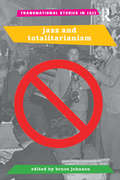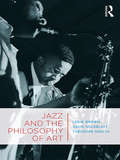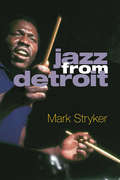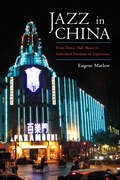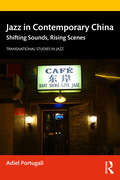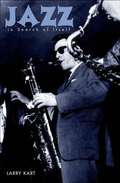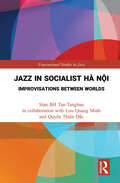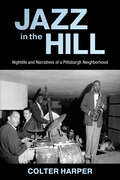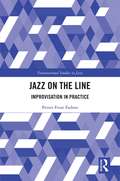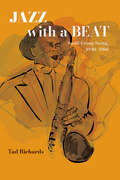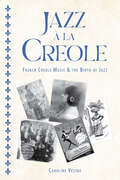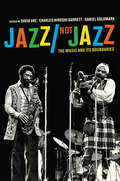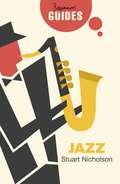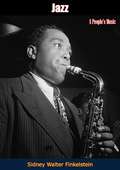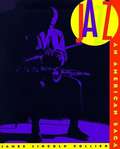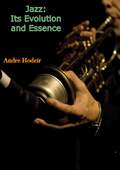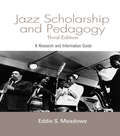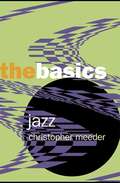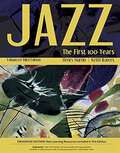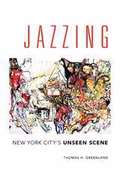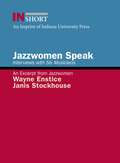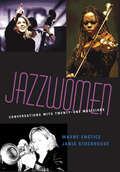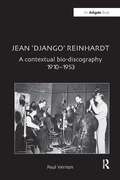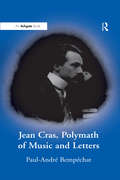- Table View
- List View
Jazz and Totalitarianism
by Bruce JohnsonJazz and Totalitarianism examines jazz in a range of regimes that in significant ways may be described as totalitarian, historically covering the period from the Franco regime in Spain beginning in the 1930s to present day Iran and China. The book presents an overview of the two central terms and their development since their contemporaneous appearance in cultural and historiographical discourses in the early twentieth century, comprising fifteen essays written by specialists on particular regimes situated in a wide variety of time periods and places. Interdisciplinary in nature, this compelling work will appeal to students from Music and Jazz Studies to Political Science, Sociology, and Cultural Theory.
Jazz and the Philosophy of Art
by David Goldblatt Lee B. Brown Theodore GracykCo-authored by three prominent philosophers of art, Jazz and the Philosophy of Art is the first book in English to be exclusively devoted to philosophical issues in jazz. It covers such diverse topics as minstrelsy, bebop, Voodoo, social and tap dancing, parades, phonography, musical forgeries, and jazz singing, as well as Goodman’s allographic/autographic distinction, Adorno’s critique of popular music, and what improvisation is and is not. The book is organized into three parts. Drawing on innovative strategies adopted to address challenges that arise for the project of defining art, Part I shows how historical definitions of art provide a blueprint for a historical definition of jazz. Part II extends the book’s commitment to social-historical contextualism by exploring distinctive ways that jazz has shaped, and been shaped by, American culture. It uses the lens of jazz vocals to provide perspective on racial issues previously unaddressed in the work. It then examines the broader premise that jazz was a socially progressive force in American popular culture. Part III concentrates on a topic that has entered into the arguments of each of the previous chapters: what is jazz improvisation? It outlines a pluralistic framework in which distinctive performance intentions distinguish distinctive kinds of jazz improvisation. This book is a comprehensive and valuable resource for any reader interested in the intersections between jazz and philosophy.
Jazz from Detroit
by Mark StrykerJazz from Detroit explores the city’s pivotal role in shaping the course of modern and contemporary jazz. With more than two dozen in-depth profiles of remarkable Detroit-bred musicians, complemented by a generous selection of photographs, Mark Stryker makes Detroit jazz come alive as he draws out significant connections between the players, eras, styles, and Detroit’s distinctive history. Stryker’s story starts in the 1940s and ’50s, when the auto industry created a thriving black working and middle class in Detroit that supported a vibrant nightlife, and exceptional public school music programs and mentors in the community like pianist Barry Harris transformed the city into a jazz juggernaut. This golden age nurtured many legendary musicians—Hank, Thad, and Elvin Jones, Gerald Wilson, Milt Jackson, Yusef Lateef, Donald Byrd, Tommy Flanagan, Kenny Burrell, Ron Carter, Joe Henderson, and others. As the city’s fortunes change, Stryker turns his spotlight toward often overlooked but prescient musician-run cooperatives and self-determination groups of the 1960s and ’70s, such as the Strata Corporation and Tribe. In more recent decades, the city’s culture of mentorship, embodied by trumpeter and teacher Marcus Belgrave, ensured that Detroit continued to incubate world-class talent; Belgrave protégés like Geri Allen, Kenny Garrett, Robert Hurst, Regina Carter, Gerald Cleaver, and Karriem Riggins helped define contemporary jazz. The resilience of Detroit’s jazz tradition provides a powerful symbol of the city’s lasting cultural influence. Stryker’s 21 years as an arts reporter and critic at the Detroit Free Press are evident in his vivid storytelling and insightful criticism. Jazz from Detroit will appeal to jazz aficionados, casual fans, and anyone interested in the vibrant and complex history of cultural life in Detroit.
Jazz in China: From Dance Hall Music to Individual Freedom of Expression
by Eugene MarlowFinalist for the 2019 Jazz Journalists Association Book of the Year About Jazz, Jazz Awards for Journalism"Is there jazz in China?" This is the question that sent author Eugene Marlow on his quest to uncover the history of jazz in China. Marlow traces China's introduction to jazz in the early 1920s, its interruption by Chinese leadership under Mao in 1949, and its rejuvenation in the early 1980s with the start of China's opening to the world under Premier Deng Xiaoping.Covering a span of almost one hundred years, Marlow focuses on a variety of subjects--the musicians who initiated jazz performances in China, the means by which jazz was incorporated into Chinese culture, and the musicians and venues that now present jazz performances.Featuring unique, face-to-face interviews with leading indigenous jazz musicians in Beijing and Shanghai, plus interviews with club owners, promoters, expatriates, and even diplomats, Marlow marks the evolution of jazz in China as it parallels China's social, economic, and political evolution through the twentieth and into the twenty-first century. Also featured is an interview with one of the extant members of the Jimmy King Big Band of the 1940s, one of the first major all-Chinese jazz big bands in Shanghai.Ultimately, Jazz in China: From Dance Hall Music to Individual Freedom of Expression is a cultural history that reveals the inexorable evolution of a democratic form of music in a Communist state.
Jazz in Contemporary China: Shifting Sounds, Rising Scenes
by Adiel PortugaliBased on interviews, conversations, and observations drawn from extensive field research, Jazz in Contemporary China: Shifting Sounds, Rising Scenes explores the current developments and conditions of Chinese jazz. Negotiating socio-political, cultural, and spatial phenomena, the author provides unique insights for understanding China’s modern history through its happenings in jazz, unveiling an insider’s look at the musicians and individuals who populate and propel these scenes. This first-hand perspective illuminates how jazz generates and disseminates practices of creativity and individuality in twenty-first-century China.
Jazz in Search of Itself
by Larry KartIn this engaging and astute anthology of jazz criticism, Larry Kart casts a wide net. Discussing nearly seventy major jazz figures and many of the music's key stylistic developments, Kart sees jazz as a unique perpetual narrative--one in which musicians, their audiences, and the evolving music itself are intimately intertwined. Because jazz arose from the collision of specific peoples under particular conditions, says Kart, its development has been unusually immediate, visible, and intense. Kart has reacted to and judged the music in a similarly active, attentive, and personal manner. His involvement and attention to detail are visible in these pieces: essays that analyze the supposed return to tradition that the music of Wynton Marsalis has come to exemplify; searching accounts of the careers of Miles Davis, Thelonius Monk, Bill Evans, and Lennie Tristano; and writing that explores jazz's relationship to American popular song and examines the jazz musician's role as actual and would-be social rebel.
Jazz in Socialist Hà Nội: Improvisations between Worlds
by Stan BH Tan-Tangbau Lưu Quang Minh Quyền Thiện ĐắcJazz in Socialist Hà Nội: Improvisations between Worlds examines the germination and growth of jazz under communist rule—perceived as the "music of the enemy" and "ideologically decadent"—in the Vietnamese capital of Hà Nội. After disappearing from the scene in 1954 following the end of the First Indochina War, jazz reemerged in the public sphere decades later at the end of the Cold War. Since then, Hà Nội has established itself as a vital and vibrant jazz center, complete with a full jazz program in the national conservatoire. Featuring interviews with principal players involved in cultivating the scene from past to present, this book presents the sociocultural encounters between musicians and the larger powers enmeshed in the broader political economy, detailing jazz’s journey to garner respect comparable to classical music as an art form possessing high artistic value. Ethnographical sketches explore how Vietnamese musicians learn and play jazz while sustaining and nurturing the scene, providing insight as to how jazz managed to grow in such an environment. Jazz in Socialist Hà Nội sheds light on those underlying caveats that allow Vietnamese jazz musicians to navigate the middle grounds between "worlds"—between music and politics—not as an act of resistance, but as realisation of artistic expression.
Jazz in the Hill: Nightlife and Narratives of a Pittsburgh Neighborhood (American Made Music Series)
by Colter HarperFrom the 1920s through the 1960s, Pittsburgh’s Hill District was the heart of the city’s Black cultural life and home to a vibrant jazz scene. In Jazz in the Hill: Nightlife and Narratives of a Pittsburgh Neighborhood, Colter Harper looks at how jazz shaped the neighborhood and created a way of life. Beyond backdrops for remarkable careers, jazz clubs sparked the development of a self-determined African American community. In delving into the history of entrepreneurialism, placemaking, labor organizing, and critical listening in the Hill District, Harper forges connections to larger political contexts, processes of urban development, and civil rights struggles.Harper adopts a broad approach in thinking about jazz clubs, foregrounding the network of patrons, business owners, and musicians who were actively invested in community building. Jazz in the Hill provides a valuable case study detailing the intersections of music, political and cultural history, public policy, labor, and law. The book addresses distinctive eras and issues of twentieth century American urban history, including notions of “vice” during the Prohibition Era (1920–1934); “blight” during the mid-twentieth century boom in urban redevelopment (1946–1973); and workplace integration during the civil rights era (1954–1968). Throughout, Harper demonstrates how the clubs, as a nexus of music, politics, economy, labor, and social relations, supported the livelihood of residents and artists while developing cultures of listening and learning. Though the neighborhood has undergone an extensive socioeconomic transformation that has muted its nightlife, this musical legacy continues to guide current development visions for the Hill on the cusp of its remaking.
Jazz on the Line: Improvisation in Practice
by Petter Frost FadnesJazz on the Line: Improvisation in Practice presents an ethnographic reflection on improvisation as performance, examining how musicians think and act when negotiating improvisational frameworks. This multidisciplinary discussion—guided by a focus on recordings, composition, authenticity, and venues—explores the musical choices made by performers, emphasizing how these choices can be logically understood within the context of controlled, musical outputs. Throughout the text, the author engages directly with musicians and their varied practices—from canonized dogmas to innovative experimentalism—offering interviews both planned and spontaneous. Musical agency is posited as a tightrope balancing act, signifying the skill and excitement of improvisational performativity and exemplifying the life of a jazzaerialist. With a travel journal approach as a backdrop, Jazz on the Line provides concepts and theories that demystify the creative processes of improvisation.
Jazz with a Beat: Small Group Swing, 1940–1960 (Excelsior Editions)
by Tad RichardsJazz with a Beat is the first book on the often overlooked but vitally important genre of small group swing jazz. Coming into being in the early 1940s, small group swing answered the need in the Black community for a form of jazz that was more accessible (and more danceable) than the new bebop. An adaptation of the big band Black swing (Erskine Hawkins, Jimmie Lunceford, Chick Webb) of the 1930s to small combos, and with a more vigorous beat for the new generation, this music developed and was beloved through the 1940s, continued to be enjoyed through the rock and roll years of the 1950s, and was a major influence on the soul jazz of the 1960s. Among the many hit artists portrayed in these pages are Illinois Jacquet, Louis Jordan, Big Jay McNeely, Joe Liggins, Nat "King" Cole, Red Prysock, Ruth Brown, Nellie Lutcher, Camille Howard, T-Bone Walker, and Ray Charles. Dismissed as "rhythm and blues," this music has been ignored by jazz historians. Jazz with a Beat honors this music as a legitimate genre of jazz and is a stirring evocation of an era. It should be of interest to lovers of jazz and Americana.
Jazz à la Creole: French Creole Music and the Birth of Jazz (American Made Music Series)
by Caroline VézinaWinner of the 2023 Award for Excellence for Best Historical Research in Recorded Jazz from the Association for Recorded Sound CollectionsDuring the formative years of jazz (1890–1917), the Creoles of Color—as they were then called—played a significant role in the development of jazz as teachers, bandleaders, instrumentalists, singers, and composers. Indeed, music penetrated all aspects of the life of this tight-knit community, proud of its French heritage and language. They played and/or sang classical, military, and dance music as well as popular songs and cantiques that incorporated African, European, and Caribbean elements decades before early jazz appeared. In Jazz à la Creole: French Creole Music and the Birth of Jazz, the author describes the music played by the Afro-Creole community since the arrival of enslaved Africans in La Louisiane, then a French colony, at the beginning of the eighteenth century, emphasizing the many cultural exchanges that led to the development of jazz. Caroline Vézina has compiled and analyzed a broad scope of primary sources found in diverse locations from New Orleans to Quebec City, Washington, DC, New York City, and Chicago. Two previously unpublished interviews add valuable insider knowledge about the music on French plantations and the danses Créoles held in Congo Square after the Civil War. Musical and textual analyses of cantiques provide new information about the process of their appropriation by the Creole Catholics as the French counterpart of the Negro spirituals. Finally, a closer look at their musical practices indicates that the Creoles sang and improvised music and/or lyrics of Creole songs, and that some were part of their professional repertoire. As such, they belong to the Black American and the Franco-American folk music traditions that reflect the rich cultural heritage of Louisiana.
Jazz/Not Jazz
by David Ake Daniel Goldmark Charles Hiroshi GarrettWhat is jazz? What is gained--and what is lost--when various communities close ranks around a particular definition of this quintessentially American music? Jazz/Not Jazz explores some of the musicians, concepts, places, and practices which, while deeply connected to established jazz institutions and aesthetics, have rarely appeared in traditional histories of the form. David Ake, Charles Hiroshi Garrett, and Daniel Goldmark have assembled a stellar group of writers to look beyond the canon of acknowledged jazz greats and address some of the big questions facing jazz today.More than just a history of jazz and its performers, this collections seeks out those people and pieces missing from the established narratives to explore what they can tell us about the way jazz has been defined and its history has been told.
Jazz: A Beginner's Guide (Beginner's Guides)
by Stuart NicholsonThis definitive guide includes a unique chapter-by-chapter playlist for the reader. Jazz: A Beginner&’s Guide is a lively and highly accessible introduction to a global musical phenomenon. Award-winning music journalist and author Stuart Nicholson takes the reader on an entertaining journey from jazz's early stirrings in America&’s south through to the present day, when almost every country in the world has its own vibrant jazz scene.En route we meet a host of jazz heroes past and present, from Louis Armstrong, Benny Goodman and Miles Davis, to Keith Jarrett and Kamasi Washington. Each chapter is accompanied by a playlist designed to provide a stimulating and enjoyable entry point to what has been described as the most exciting art form of all.
Jazz: A People’s Music
by Sidney Walter FinkelsteinTHE PLACE OF JAZZ IN WORLD MUSIC…ITS HISTORY FROM NEW ORLEANS TO THE PRESENT DAY…ITS BEAUTY AS MUSIC…AND THE GREATNESS OF THE PEOPLE WHO MADE IT…This is a book for everyone who loves music—classical or jazz; for the one who performs or the one who makes up his audience. To either one it will contribute much for a better understanding and appreciation of this greatest and most widely participated in art.Everyone knows about jazz. We listen to it, we sing it, play it and dance to it. Yet it is the great unknown music.Jazz, A People’s Music describes all the developments of jazz from the early blues to present-day “bebop.” And just as the study of a composer’s music must include the man himself, here is an account of the growth of jazz as well as the study of all the American people, of every nationality and color, who have nurtured and welcomed this music and brought new and exciting variations of it into being.
Jazz: An American Saga
by James Lincoln CollierOne thing we can be sure of is that jazz was invented in America. From the small sunlit barns that dotted the Louisiana countryside around the turn of the century to the booming nightspots in New York in the 1920s, America has always been the home of jazz. But how did jazz get started? Who were its first musicians? And what was it about America that made it the birthplace of this century's greatest music? Newbery Honor-winner and jazz critic James Lincoln Collier tackles these questions and others, tracing the history and evolution of jazz in America. Beginning with the African tribal music transported here by slaves, Collier reveals the roots of jazz in gospel and ragtime before launching into a discussion of Dixieland, swing, bebop, the cool school, free jazz, and fusion. Along the way, we meet the great personalities who shaped the music: giants like Louis Armstrong and Duke Ellington, who brought jazz into the mainstream; mavericks like Dizzy Gillespie and Charlie Parker, who toyed with its sound and structure; and avant-gardists like Ornette Coleman and John Coltrane, who revolutionized and reinvented jazz. In this lively, sometimes controversial photo-filled account, Collier shows us how jazz became an international craze, all the while remaining as American as apple pie.
Jazz: Its Evolution and Essence
by Andre HodeirClassic collection of essays on jazz music and musicians by a French critic and music historian.“First trained as a violinist, then as a composer, André Hodeir began writing about jazz in the 1940s. As editor-in-chief of the French magazine Jazz Hot, he was an early proponent of bebop and its practitioners, Charlie Parker and Dizzy Gillespie.Downbeat called Hodeir's first compilation of jazz writings, Jazz: Its Evolution and Essence, "the best analytical book on jazz ever written," and Martin Williams named it and Hodeir's second book, Toward Jazz, "two of the most important critical works ever written on the subject." While Hodeir's ideas sparked widespread debate, his study of jazz improvisation and his use of music theory shed new light on the intricacies of jazz composition and arrangement and helped launch a new era of jazz criticism.”-UMICH.edu
Jazz: Research and Pedagogy (Routledge Music Bibliographies #No. 4)
by Eddie S. MeadowsJazz: Research and Pedagogy is the third edition of an annotated bibliography to books, recordings, videos, and websites in the field of jazz. Since the publication of the 2nd edition in 1995, the quantity and quality of books on jazz research, performance, and teaching materials have increased. Although the 1995 book was the most comprehensive annotated jazz bibliography published to that date, several books on research, performance, and teaching materials were omitted. In addition, given the proliferation of new books in all jazz areas since 1995, the need for a new, comprehensive, and annotated reference book on jazz is apparent. Multiply indexed, this book will serve as an excellent tool for librarians, researchers, and scholars in sorting through the massive amount of new material that has appeared in the field over the last decade.
Jazz: The Basics (The Basics)
by Christopher MeederJazz: The Basics gives a brief introduction to a century of jazz, ideal for students and interested listeners who want to learn more about this important musical style. The heart of the book traces jazz's growth from its folk origins through early recordings and New Orleans stars; the big-band and swing era; bebop; cool jazz and third stream; avant-garde; jazz-rock; and the neo-conservative movement of the 1980s and 1990s. Key figures from each era including: Louis Armstrong, Benny Goodman, Charlie Parker, Miles Davis, and Wynton Marsalis are highlighted along with classic works. The book concludes with a list of the 100 essential recordings to own, along with a timeline and glossary. Jazz: The Basics serves as an excellent introduction to the players, the music, and the styles that make jazz 'America's classical music.'
Jazz: The First 100 Years
by Henry Martin Keith WatersEquipping you with a true feel for the vibrant, ever-changing sound of jazz, the captivating JAZZ: THE FIRST 100 YEARS, ENHANCED MEDIA EDITION, 3e explores the development of jazz music from its nineteenth-century roots in blues and ragtime, through swing and bebop, to fusion and contemporary jazz styles. Biographies, social history, and timelines at the beginning of chapters put music into context, while insightful listening guides tie the history of jazz music directly to the downloadable selections. All-new interactive pre- and post-chapter quizzes help prepare you for upcoming topics as well as review what you have already learned. In addition, Audio Primer selections allow you to hear the key terms, basic music concepts, and jazz instruments discussed in the book. A printed access card with all of the music for the book comes with every copy of the printed text, and is also available via MindTap.
Jazzing: New York City's Unseen Scene
by Thomas H. GreenlandHow do we speak about jazz? In this provocative study based on the author's deep immersion in the New York City jazz scene, Tom Greenland turns from the usual emphasis on artists and their music to focus on non-performing participants, describing them as active performers in their own right who witness and thus collaborate in a happening made one-of-a-kind by improvisation, mood, and moment. Jazzing shines a spotlight on the constituency of proprietors, booking agents, photographers, critics, publicists, painters, amateur musicians, fans, friends, and tourists that makes up New York City's contemporary jazz scene. Drawn from deep ethnographic research, interviews, and long term participant observation, Jazzing charts the ways New York's distinctive physical and social-cultural environment affects and is affected by jazz. Throughout, Greenland offers a passionate argument in favor of a radically inclusive conception of music-making, one in which individuals collectively improvise across social contexts to co-create community and musical meaning. An odyssey through the clubs and other performance spaces on and off the beaten track, Jazzing is an insider's view of a vibrant urban art world.
Jazzocracy: Jazz, Democracy, and the Creation of a New American Mythology
by Kabir SehgalSehgal explores the nature of jazz as it relates to the liberty and freedoms of a democratic nation.
Jazzwomen Speak
by Wayne Enstice Janis StockhouseA woman in jazz. How was she treated on- and offstage? What was it like to play with Dizzy Gillespie or Charlie Parker? What was the breakthrough moment in her career? How did she balance her personal and professional life? In six illuminating interviews, female jazz musicians answer these questions and more, discussing the challenges of being a woman in a scene historically dominated by men. Jazzwomen Speak gathers the voices of women whose careers highlight the bebop and post-bop era of jazz, as they share stories of their musical training and entrance into the jazz world, relationships and encounters with other musicians, limitations on the bandstand and in the recording studio, and how being a female musician has formed their musical performances over time.
Jazzwomen: Jazzwomen: Conversations With Twenty-one Musicians (Profiles In Popular Music Ser.)
by Wayne Enstice Janis Stockhouse"Their conversations range far beyond the biographical--to their feelings, motivations, musical approaches, and attitudes. These women were obviously comfortable with their questioners. [Enstice and Stockhouse] came prepared, having delved deeply into the music and history of each, bringing them closer to the essence of each musician." --from the Preface by Cobi Narita and Paul Ash"Jazzwomen includes many artists who are not covered in earlier books and also reveals new information about artists who are. In addition, the interview format used in Jazzwomen provides the reader with each artist's own words, permeated with a warmth and immediacy not typically found in author narratives. Jazzwomen is a much-needed book." --David N. Baker, Distinguished Professor of Music and Chairman, Jazz Department, Indiana University School of Music; and Artistic and Musical Director, Smithsonian Jazz Masterworks OrchestraBetween 1995 and 2000, Wayne Enstice and Janis Stockhouse interviewed dozens of women jazz instrumentalists and vocalists. Jazzwomen collects 21 of the most fascinating interviews. The participants discuss everything--their personal lives, musical training and inspirations, recordings, relationships with other musicians, the music industry, sexism on the bandstand--and often make candid and revealing statements. At the end of each interview is a recommended discography compiled by the authors.Every jazz listener, musician, teacher, and student will be captivated by interviews with Marian McPartland, Regina Carter, Abbey Lincoln, Cassandra Wilson, Diana Krall, and their peers. Includes a sampler CD with complete works by several of the artists, including Jane Ira Bloom and Ingrid Jensen.
Jean 'Django' Reinhardt: A Contextual Bio-Discography 1910-1953
by Paul VernonThis volume gathers together and organizes in an easily accessible format all known information relevant to the life and work of the French jazz musician Django Reinhardt. Together with fellow musician, St ane Grappelli, Reinhardt became one of the twentieth century's most celebrated jazz artists with performances he gave as part of the Quintet of the Hot Club of France. Essentially discographical in format, this book updates the original work compiled by Charles Delauney in 1960, and draws on later work by Gould, Nevers, Royal and Rust, to detail all known recordings by Reinhardt, together with known film, radio and television appearances. For each entry Paul Vernon provides, where known, the location of the recording, the date, the artist credit as it appears on the label of the original issue, the performers and the instruments played by them, the matrix number, the exact timing of the recording and details of 78, LP, EP and CD issues. Interspersed at the appropriate chronological points are biographical details about Reinhardt and the political, social and cultural climate of his time. This is augmented with excerpts from reviews, letters and other documents to provide a vivid context for his recording work.
Jean Cras, Polymath of Music and Letters
by Paul-André BempéchatJean Cras (1879-1932) was a remarkable man by anyone's measure. Twice a decorated hero of the Great War, this Rear-Admiral of the French navy, scientist, inventor and moral philosopher, was also a highly esteemed composer during his lifetime, enjoying the same stature and celebrity as Faur Debussy and Ravel. Since his death, however, both Cras and his music have been almost completely overlooked. In this, the first critical biography of Cras, Paul-Andre Bempechat situates Henri Duparc's proteg‘s a missing link between the French post-Romantic generation of composers and the Impressionists. The book explores, both historically and analytically, the methodology by which Cras evolved his eclectic brand of Impressionism, striking the delicate balance between Celtic folk idioms and exoticisms inspired by his travels. Cras' creative legacy extends beyond the world of music to the world of science. His five patented inventions include the navigational gyrocompass, which bears his name, still in use to this day by the French navy, coast guard and boating afficionados. Bempechat draws special attention to the humanist Jean Cras and his distinguished military career - he is credited with saving the Serbian army from extinction - drawing on primary source material such as family correspondence and wartime diaries to reaffirm this composer as a true Renaissance man of the twentieth century.
